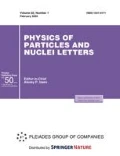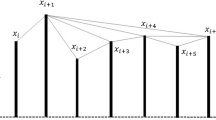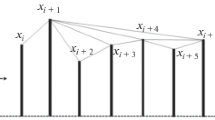Abstract
Various works on multiplicity fluctuation have investigated the dynamics of particle production process and eventually have tried to reveal a signature of phase transition in ultra-relativistic nuclear collisions. Analysis of fluctuations of spatial patterns has been conducted in terms of conventional approach. However, analysis with fractal dynamics on the scaling behavior of the void has not been explored yet. In this work we have attempted to analyze pion fluctuation in terms of the scaling behavior of the void probability distribution in azimuthal space in ultra-relativistic nuclear collisions in the light of complex networks. A radically different and rigorous method viz. Visibility Graph was applied on the data of 32S-Ag/Br interaction at an incident energy of 200 GeV per nucleon. The analysis reveals strong scaling behavior of void probability distributions in azimuthal space and a strong centrality dependence.
Similar content being viewed by others
References
D. Ghosh, A. Deb, S. Bhattacharyya, J. G. R. Das, and S. Mukherjee, “Evidence of intermittent type fluctuation of target residue in relativistic nuclear collisions at a few GeV/N,” Int. J. Mod. Phys. E 12, 407–419 (2003).
S. Sarkar, T. Goswami, D. Ghosh, and A. Deb, “Intermittency in the slow particle emission during hadron nucleus interactions,” Czechosl. J. Phys. 53, 133–141 (2003).
A. Bialas and B. Ziaja, “Intermittency in a single event,” Phys. Lett. B 378, 319–322 (1996).
D. Ghosh, P. Ghosh, A. Ghosh, and J. Roy, “Intermittency and fragmentation of target residue in highenergy nuclear interactions,” Phys. Rev. 49, R1747–R1750 (1994).
D. Ghosh, A. Deb, M. Lahiri, A. Dey, S. A. Hossain, S. Das, S. Sen, S. Halder, and J. Roy, “Multihadron production in high-energy interactions and intermittency,” Phys. Rev. D 49, 3113–3119 (1994).
D. Ghosh, P. Ghosh, A. Ghosh, and J. Roy, “Nonstatistical fluctuations in fragmentation of target nuclei in high energy nuclear interactions,” J. Phys. G: Nucl. Part. Phys. 20, 1077–1082 (1994).
D. Ghosh, A. K. Jafry, A. Deb, S. Sarkar, R. Chattopadhyay, and S. Das, “Multidimensional intermittency analysis in ultrarelativistic heavy ion interaction,” Phys. Rev. C 59, 2286–2288 (1999).
“Factorial, multifractal moments and short-range correlation of shower particles at relativistic energies," Nucl. Phys. A 596, 700–712 (1996).
D. Ghosh, J. Roy, M. Basu, K. Sengupta, S. Naha, A. Bhattacharyya, and T. G. Thakurta, “Rapidity-gap and rapidity-correlation study in 400-GeV/c protonnucleus interactions,” Phys. Rev. D 26, 2983–2990 (1982).
D. Ghosh, K. Purkait, and R. Sengupta, “Correlation among target fragments in ‘hot’ and ‘cold’ events in relativistic heavy ion interaction,” Acta Phys. Slov. 47, 425–430 (1997).
D. Ghosh, A. Deb, S. Bhattacharyya, M. Mondol, R. Das, J. Ghosh, K. Chattopadhayay, R. Sarkar, S. Mukherjee, S. Biswas, et al., “Target fragmentation in 28Si-AgBr interactions at 14.5 AGeV-evidence for two-and many-particle dynamical correlations,” Fizika B (Zagreb) 11 (1/4), 73–82 (2002).
R. C. Hwa and Q.-h. Zhang, “Erraticity of rapidity gaps,” Phys. Rev. D 62, 014003 (2000).
R. C. Hwa, “Fractal measures in multiparticle production,” Phys. Rev. D 41, 1456–1462 (1990).
F. Takagi, “Multifractal structure of multiplicity distributions in particle collisions at high energies,” Phys. Rev. Lett. 72, 32–35 (1994).
G. Paladin and A. Vulpiani, “Anomalous scaling laws in multifractal objects,” Phys. Rep. 156, 147–225 (1987).
P. Grassberger and I. Procaccia, “Dimensions and entropies of strange attractors from a fluctuating dynamics approach,” Phys. D: Nonlin. Phenom. 13, 34–54 (1984).
T. C. Halsey, M. H. Jensen, L. P. Kadanoff, I. Procaccia, and B. I. Shraiman, “Fractal measures and their singularities: the characterization of strange sets,” Phys. Rev. A 33, 1141–1151 (1986).
D. Ghosh, A. Mukhopadhyay, A. Ghosh, and J. Roy, “Zonal poissonian pion multiplicity in central 24Mg-AgBr collisions at Dubna energy,” Mod. Phys. Lett. A 04, 1197–1202 (1989).
D. Ghosh, M. Lahiri, A. Deb, S. Das, K. Purkait, B. Biswas, J. Roychoudhury, R. Chatterjee, and A. K. Zafri, “Factorial correlator study in Ag32/Br interaction at 200A GeV,” Phys. Rev. C 52, 2092–2096 (1995).
D. Ghosh, M. Momdal, A. Deb, and A. Ghosh, “Erractivity analysis of multipion data in 32A-AgBr interactions at 200A GeV,” Phys. Rev. D: Part. Fields 68, 024908 (2003).
D. Ghosh, P. Ghosh, A. Deb, and D. Halder, S. Das, A. Hossain, A. Dey, and J. Roy, “Self-similarity in particle production in hadron-nucleus interactions at 350 and 200 GeV/c,” Phys. Rev. D 46, 3712–3719 (1992).
D. Ghosh, S. Sen, and J. Roy, “Maximum fluctuations of particle densities in narrow pseudorapidity space in high-energy interaction of hadrons with nuclei,” Phys. Rev. D 47, 1235–1238 (1993).
D. Ghosh, A. Deb, S. R. Sahoo, and P. K. Haldar, “A study on azimuthal asymmetry of emission of pions produced in ultra-relativistic nuclear collisions,” Europhys. Lett. 56, 639–643 (2001).
D. Ghosh, A. Deb, M. Mondal, and J. Ghosh, “Analysis of fluctuation of fluctuations in 32S-AgBr interactions at 200 AGeV,” Phys. Lett. B 540, 52–61 (2002).
D. Ghosh, A. Deb, M. Mondal, and J. Ghosh, “Multiplicity- dependent chaotic pionization in ultra-relativistic nuclear interactions,” J. Phys. G: Nucl. Part. Phys. 29, 2087–2098 (2003).
D. Ghosh, A. Deb, S. Bhattacharyya, and U. Datta, “Multiplicity scaling of target protons in high-energy nucleus-nucleus and hadron-nucleus interactions,” J. Phys. G: Nucl. Part. Phys. 39, 035101 (2012).
M. S. Taqqu, V. Teverovsky, and W. Willinger, “Estimators for long-range dependence: an empirical study,” Fractals 03, 785–798 (1995).
Z. Chen, P. C. Ivanov, K. Hu, and H. E. Stanley, “Effect of nonstationarities on detrended fluctuation analysis,” Phys. Rev. E 65, 041107 (2002).
C. K. Peng, S. V. Buldyrev, S. Havlin, M. Simons, H. E. Stanley, and A. L. Goldberger, “Mosaic organization of DNA nucleotides,” Phys. Rev. E 49, 1685–1689 (1994).
J. W. Kantelhardt, S. A. Zschiegner, E. Koscielny-Bunde, S. Havlin, A. Bunde, and H. Stanley, “Multifractal detrended fluctuation analysis of nonstationary time series,” Physica A 316, 87–114 (2002).
J. W. Kantelhardt, E. Koscielny-Bunde, H. H. Rego, S. Havlin, and A. Bunde, “Detecting long-range correlations with detrended fluctuation analysis,” Physica A 295, 441–454 (2001).
S. Bhaduri and D. Ghosh, “Speech, music and multifractality,” Curr. Sci. 110, 1817 (2016).
S. Bhaduri and D. Ghosh, “Non-invasive detection of alzheimer’s disease—multifractality of emotional speech,” J. Neurol. Neurosci. (2016).
S. Dutta, “Multifractal properties of ECG patterns of patients suffering from congestive heart failure,” J. Stat. Mech.: Theory Exp. 2010, 12021 (2010).
S. Dutta, D. Ghosh, and S. Chatterjee, “Multifractal detrended fluctuation analysis of human gait diseases,” Front. Physiol. 4 (2013).
D. Ghosh, S. Dutta, and S. Chakraborty, “Multifractal detrended cross-correlation analysis for epileptic patient in seizure and seizure free status,” Chaos, Solitons Fractals 67, 1–10 (2014).
Y. X. Zhang, W. Y. Qian, and C. B. Yang, “Multifractal structure of pseudorapidity and azimuthal distributions of the shower particles in Au + Au collisions at 200 A GeV,” Int. J. Mod. Phys. A 23, 2809–2816 (2008).
D. Ghosh, A. Deb, and M. Lahiri, “Factorial and fractal analysis of the multipion production process at 350 GeV/c,” Phys. Rev. D 51, 3298–3304 (1995).
D. Ghosh, A. Deb, P. Bandyopadhyay, M. Mondal, S. Bhattacharyya, J. Ghosh, and K. Kumar Patra, “Evidence of multifractality and constant specific heat in hadronic collisions at high energies,” Phys. Rev. C 65, 067902 (2002).
D. Ghosh, A. Deb, S. Pal, P. K. Haldar, S. Bhattacharyya, P. Mandal, S. Biswas, and M. Mondal, “Evidence of fractal behavior of pions and protons in high energy interactions–an experimental investigation,” Fractals 13, 325–339 (2005).
S. Dutta, D. Ghosh, and S. Chatterjee, “Multifractal detrended fluctuation analysis of pseudorapidity and azimuthal distribution of pions emitted in high energy nuclear collisions,” Int. J. Mod. Phys. A 29, 1450084 (2014).
P. Mali, S. Sarkar, S. Ghosh, A. Mukhopadhyay, and G. Singh, “Multifractal detrended fluctuation analysis of particle density fluctuations in high-energy nuclear collisions,” Physica A 424, 25–33 (2015).
L. Lacasa, B. Luque, F. Ballesteros, and J. Luque, “From time series to complex networks: the visibility graph,” Proc. Natl. Acad. Sci. USA 105, 4972–4975 (2008).
L. Lacasa, B. Luque, and J. Luque, “The visibility graph: a new method for estimating the hurst exponent of fractional Brownian motion,” Europhys. Lett. 86, 30001 (2009).
S. Jiang, C. Bian, X. Ning, and Q. D. Y. Ma, “Visibility graph analysis on heartbeat dynamics of meditation training,” Appl. Phys. Lett. 102, 253702 (2013).
S. Bhaduri and D. Ghosh, “Electroencephalographic data analysis with visibility graph technique for quantitative assessment of brain dysfunction,” Clin. EEG Neurosci. 46, 218–223 (2015).
A. Bhaduri and D. Ghosh, “Quantitative assessment of heart rate dynamics during meditation: an ECG based study with multi-fractality and visibility graph,” Front. Physiol. 7 (2016).
G. Zebende, M. Silva, A. Rosa, A. Alves, J. de Jesus, and M. Moret, “Studying long-range correlations in a liquid-vapor-phase transition,” Physica A 342, 322–328 (2004).
L. Zhao, W. Li, C. Yang, J. Han, Z. Su, Y. Zou, and X. Cai, “Multifractal and network analysis of phase transition,” (2017). doi 10.1371/journal.pone.0170467
S. Bhaduri and D. Ghosh, “Study of void probability scaling of pions in ultrarelativistic nuclear collision in fractal scenario,” (2017, in press).
N. S. Amelin, E. F. Staubo, L. P. Csernai, V. D. Toneev, K. K. Gudima, and D. Strottman, “Transverse flow and collectivity in ultrarelativistic heavy-ion collisions,” Phys. Rev. Lett. 67, 1523–1526 (1991).
J.-Y. Ollitrault, “Anisotropy as a signature of transverse collective flow,” Phys. Rev. D 46, 229–245 (1992).
S. Mrówczyński, “Plasma instability at the initial stage of ultrarelativistic heavy-ion collisions,” Phys. Lett. B 314, 118–121 (1993).
M. Ahmadlou, H. Adeli, and A. Adeli, “Improved visibility graph fractality with application for the diagnosis of autism spectrum disorder,” Physica A 391, 4720–4726 (2012).
C. F. Powell, P. H. Fowler, and D. H. Perkins, The Study of Elementary Particles by the Photographic Method (Pergamon, New York, 1959).
N. Agababyan, M. Atayan, and M. Charlet, J. Czyejewski, E. de Wolf, K. Dziunikowska, A. Endler, Z. Garutchava, H. Gulkanyan, R. Hakobyan, J. Karamyan, D. Kisielewska, W. Kittel, L. Liu, S. Mehrabyan, et al., “Self-affine fractality in π + p and K + p collisions at 250 GeV/c,” Phys. Lett. B 382, 305–311 (1996).
Author information
Authors and Affiliations
Corresponding author
Additional information
The article is published in the original.
Rights and permissions
About this article
Cite this article
Bhaduri, A., Bhaduri, S. & Ghosh, D. Azimuthal pion fluctuation in ultra relativistic nuclear collisions and centrality dependence—a study with chaos based complex network analysis. Phys. Part. Nuclei Lett. 14, 576–583 (2017). https://doi.org/10.1134/S1547477117040033
Received:
Published:
Issue Date:
DOI: https://doi.org/10.1134/S1547477117040033




